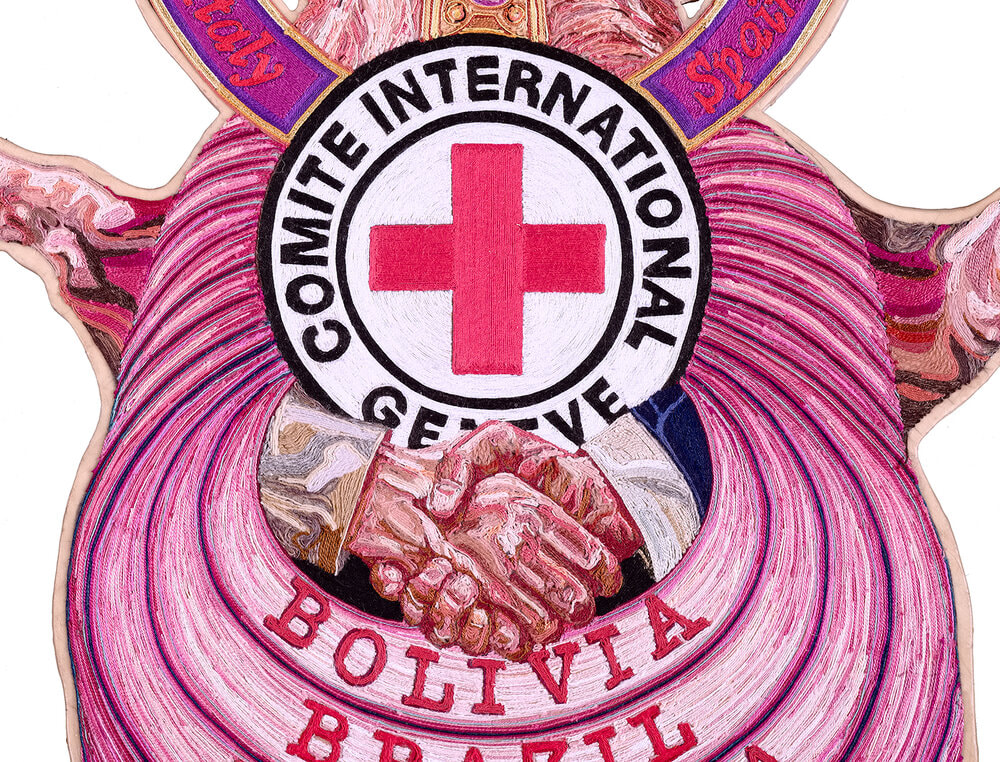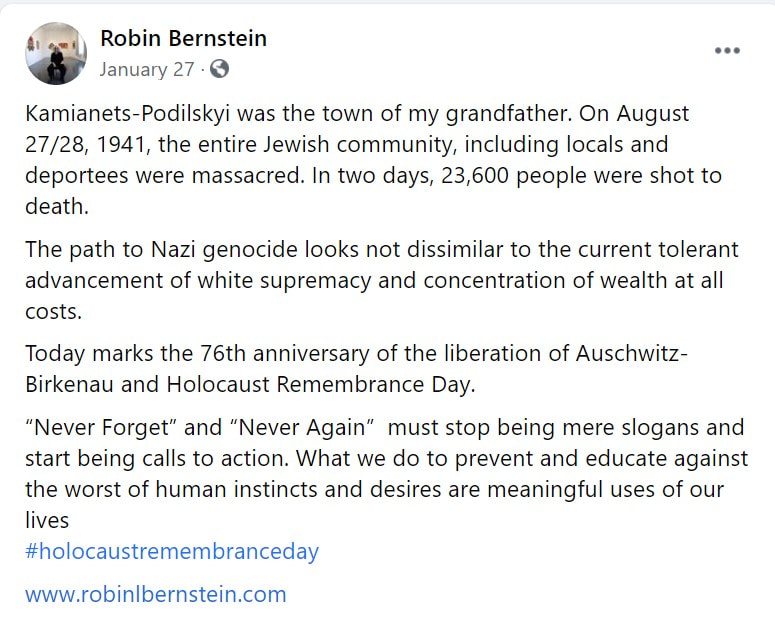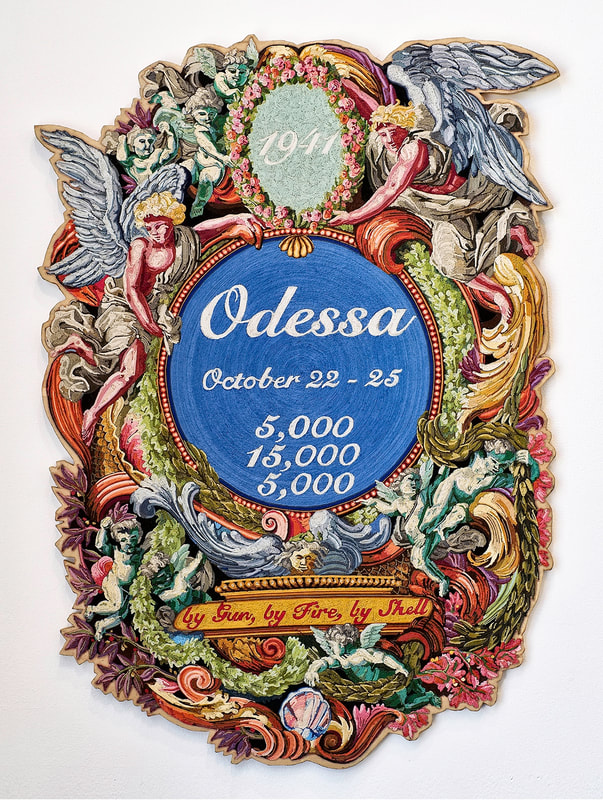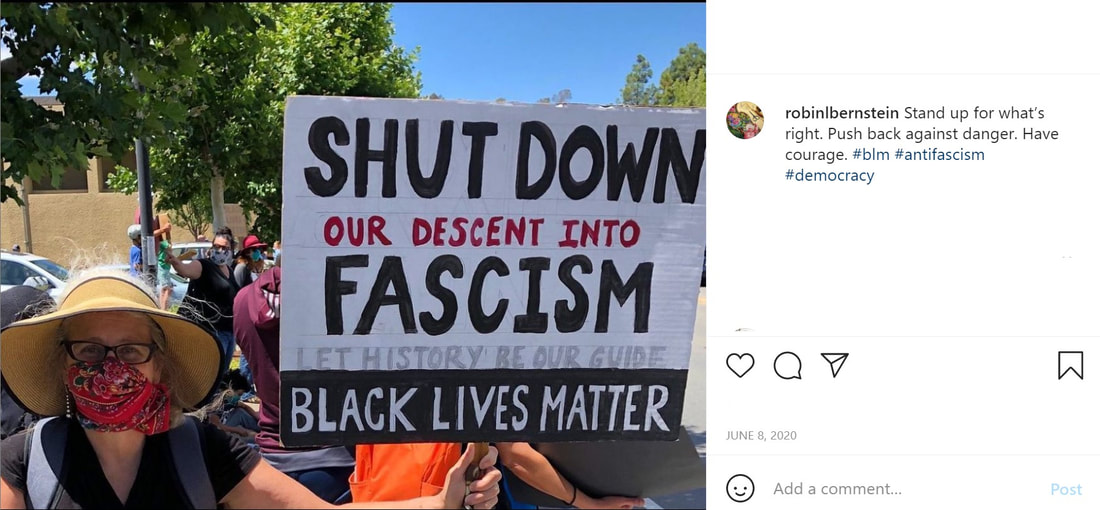Robin Bernstein
https://www.robinlbernstein.com/current-work
https://www.instagram.com/robinlbernstein/?hl=en
https://www.facebook.com/robin.bernstein.12
Artist Statement
At first glance, these artworks defy a clear medium and process. They appear to be embroidered or woven, made of mosaic, painted, or sewn. The colors are rich and the forms are attractive. They are “beautiful”. The viewer is inclined to step very close to examine the surface. The subject matter then becomes viscerally apparent. A paragraph of text accompanies each piece, which retells the horrific act of violence and terror that the artwork memorializes. Each piece is an example of how people will behave under set conditions. Many of these particular pieces refer to lesser-known Holocaust crimes. Much of the string that is used is vintage and originated in Europe. Each piece is composed of thousands of tiny cut pieces of string that have been pressed into a bed of wax and brushed onto cut plywood. Each work takes between 4 and 6 months to create.
Artist Biography
Robin L. Bernstein was born in St Louis, Missouri into a distinctly non-artistic family. Luckily, music was played and encouraged which lay the groundwork for creative, visual expression.
Bernstein studied Art in St Paul, MN, Champaign-Urbana, IL, and San Francisco, CA, before settling in Emeryville and Canyon, CA. She earned her MFA in Painting and Drawing but upon discovering wood construction began to combine woodcarvings with thinly cut sheet metal, hammered together with thousands of tiny escutcheon pins. Years later, and along a similarly obsessive vein, she began pressing colored string into wax after learning about the Huichol Indians and their spiritual practices in Central Mexico.
Robin’s current subject matter combined with her artistic technique is her way of shouting from the rooftops: those who cannot remember the past are condemned to repeat it. Human behavior being highly predictable, after all. Robin and her husband have two children, now young adults.
https://www.instagram.com/robinlbernstein/?hl=en
https://www.facebook.com/robin.bernstein.12
Artist Statement
At first glance, these artworks defy a clear medium and process. They appear to be embroidered or woven, made of mosaic, painted, or sewn. The colors are rich and the forms are attractive. They are “beautiful”. The viewer is inclined to step very close to examine the surface. The subject matter then becomes viscerally apparent. A paragraph of text accompanies each piece, which retells the horrific act of violence and terror that the artwork memorializes. Each piece is an example of how people will behave under set conditions. Many of these particular pieces refer to lesser-known Holocaust crimes. Much of the string that is used is vintage and originated in Europe. Each piece is composed of thousands of tiny cut pieces of string that have been pressed into a bed of wax and brushed onto cut plywood. Each work takes between 4 and 6 months to create.
Artist Biography
Robin L. Bernstein was born in St Louis, Missouri into a distinctly non-artistic family. Luckily, music was played and encouraged which lay the groundwork for creative, visual expression.
Bernstein studied Art in St Paul, MN, Champaign-Urbana, IL, and San Francisco, CA, before settling in Emeryville and Canyon, CA. She earned her MFA in Painting and Drawing but upon discovering wood construction began to combine woodcarvings with thinly cut sheet metal, hammered together with thousands of tiny escutcheon pins. Years later, and along a similarly obsessive vein, she began pressing colored string into wax after learning about the Huichol Indians and their spiritual practices in Central Mexico.
Robin’s current subject matter combined with her artistic technique is her way of shouting from the rooftops: those who cannot remember the past are condemned to repeat it. Human behavior being highly predictable, after all. Robin and her husband have two children, now young adults.
Frontman (Funding Facism, Fueling Fallacy)
|
Frontman (Funding Facism, Fueling Fallacy)
An artwork that reflects the relationship between Donald Trump and Robert and Rebekah Mercer. Father and Daughter Robert and Rebekah Mercer are the billionaire donors and virulent supporters of Trump and Steve Bannon, cofounders of Cambridge Analytica and main stakeholders in Breitbart News. They have given upwards of $100M to conservative think tanks, the GOP, and climate misinformation groups. Apparently, they are quite proud of being responsible for Trump’s public denial of climate change. Detail: Frontman (Funding Facism, Fueling Fallacy), 2017 string and wax on wood, 26” x 29” |
The Love - Black Eyed Peas and Jennifer Hudson
Oct 19, 2020
Oct 19, 2020
The White Rose
|
The White Rose
Despite anti-Nazi speech being relentlessly prosecuted by the Gestapo (German State Secret Police) a group of University students formed The White Rose, a nonviolent intellectual resistance group. They wrote, printed, and distributed 15,000 leaflets advocating nonviolent resistance in denouncing persecution, the mass murder of Jews, and the end to the war. 7 core members, most in their early 20s, were executed by guillotine in 1943. Across the world, The White Rose has come to symbolize opposition to tyranny and a fight for freedom. Have Courage detail, The White Rose, 2019, string and wax on wood, 42” x 33” |
A Failure of Justice
|
“Most of the power of authoritarianism is freely given. Do not obey in advance”
~Timothy Snyder |
A Failure of Justice
By March of 1955, West Germany was independently adjudicating all war crimes and crimes against humanity committed by its citizens during the Third Reich. It is estimated that there were over 750,000 German people actively involved in mass murder. West German courts, prosecutors, and police committed a failure of justice so extreme as to find innocent all those who used as a legal defense: I WAS ONLY DOING MY JOB. A Failure of Justice, 2020 string and wax on wood 52” x 38” |
Ratlines
|
Ratlines
The Ratlines were a series of secret escape routes (primarily) across Italy and Spain, established at the end of WW2. Their sole purpose was to help high ranking Nazi war criminals escape justice. The International Red Cross provided 10,000 blank travel documents to the Vatican, which then actively provided sanctuary and transport, thus aiding in their escape to South America. Some of the most notorious Nazis left Europe via the Ratlines, including Eichmann, Mengele, Barbie, Stangl, Rauff, Priebke, and others. Ratlines, 2020, string and wax on wood, 76” x 52” |
Harvest Festival
Harvest Festival
Beginning at dawn on November 3, 1943 the Nazis responded to ever increasing Jewish resistance. The armed conflicts in the Warsaw, Bialystok, and Vilna ghettos, and the uprisings at Sobibor and Treblinka sent the Nazis into a murderous rage. Despite the economic necessity of keeping the forced labor camps in the Lublin District fully operational, they decided instead to kill every Jew, naming the operation - Harvest Festival. 18,400 Jews, separated from other prisoners, were killed in a single day at Majdanek, 4,000 at Trawniki, and 11,000 in two days at Poniatowa. The murders were committed by the SS, by Police Battalion 101, and the Hiwis/Trawniki Men (volunteer collaborators from Eastern and Central Europe, mostly Soviet POWs). The massacre at Majdanek was the largest single-day, single-location mass murder during the Holocaust.
Harvest Festival, string and wax on wood, 46” x 34”
Beginning at dawn on November 3, 1943 the Nazis responded to ever increasing Jewish resistance. The armed conflicts in the Warsaw, Bialystok, and Vilna ghettos, and the uprisings at Sobibor and Treblinka sent the Nazis into a murderous rage. Despite the economic necessity of keeping the forced labor camps in the Lublin District fully operational, they decided instead to kill every Jew, naming the operation - Harvest Festival. 18,400 Jews, separated from other prisoners, were killed in a single day at Majdanek, 4,000 at Trawniki, and 11,000 in two days at Poniatowa. The murders were committed by the SS, by Police Battalion 101, and the Hiwis/Trawniki Men (volunteer collaborators from Eastern and Central Europe, mostly Soviet POWs). The massacre at Majdanek was the largest single-day, single-location mass murder during the Holocaust.
Harvest Festival, string and wax on wood, 46” x 34”
#holocaustremembranceday
Volary
Volary
January 20, 1945
1,350 Jewish women prisoners were forcibly marched 550 miles from three concentration camps in freezing temperatures for 106 days. 118 managed to survive murder, starvation, exposure, and utter brutality at the hands of their SS guards. After being liberated by American forces on May 5, in Volary, Czechoslovakia, 26 of the women died within days (of frostbite, dysentery, and severe injuries to the feet). The Germans knowingly marched these women to their deaths as the Russians approached and a German defeat became evident. In the last 10 months of World War 2, approximately 250,000 people died on forced death marches such as these.
Volary, 2018, string and wax on wood, 35” x 29”
January 20, 1945
1,350 Jewish women prisoners were forcibly marched 550 miles from three concentration camps in freezing temperatures for 106 days. 118 managed to survive murder, starvation, exposure, and utter brutality at the hands of their SS guards. After being liberated by American forces on May 5, in Volary, Czechoslovakia, 26 of the women died within days (of frostbite, dysentery, and severe injuries to the feet). The Germans knowingly marched these women to their deaths as the Russians approached and a German defeat became evident. In the last 10 months of World War 2, approximately 250,000 people died on forced death marches such as these.
Volary, 2018, string and wax on wood, 35” x 29”
Vel D’Hiv
|
Vel D’Hiv
Beginning at 4 AM, on July 16, 1942, the French Police rounded up and arrested 13,152 Jews in Paris. Each person was instructed to bring one blanket, one sweater, a pair of shoes and two shirts. They were held in extremely crowded conditions at Velodrome d’Hiver, a professional bicycle racing arena one block from the Eiffel Tower. About 6000 were taken to a transit camp and on to Auschwitz the following day, but 7000 remained at Vel D’Hiv in extreme heat without water, food or sanitary facilities. After 5 days, the remaining adults were taken, leaving the children (ages 16 and under) behind. Over 3,000 children were sent via rail cattle cars to their deaths in Auschwitz from Vel D’Hiv. The youngest was 18 months old. Vel D'Hiv 2016 string and wax on wood, 41” x 26” |
Morning Until Evening
Morning Until Evening
An 8 year-old Polish boy incited the Kielce Pogrom after the end of the war. This boy, named Henryk Błaszczyk, and his father accused local holocaust survivors of kidnapping Polish children, holding them in a building at 7 Platy Street, and committing “ritual murder”. This resulted in a massacre of innocent survivors including Jewish men, women, and children. In 1998, when that boy turned 60 years old, he told a journalist that the entire story was a lie. The ruthlessness of this action and these murders sent the international message that Jews would not be safe to return to their homes across Europe - and thus began a mass exodus of survivors.
There are only about 20,000 people with Jewish ancestry currently living in Poland. Before the war, there were 3,000,000.
Morning Until Evening, 2018, string and wax on wood, 33” x 38”
An 8 year-old Polish boy incited the Kielce Pogrom after the end of the war. This boy, named Henryk Błaszczyk, and his father accused local holocaust survivors of kidnapping Polish children, holding them in a building at 7 Platy Street, and committing “ritual murder”. This resulted in a massacre of innocent survivors including Jewish men, women, and children. In 1998, when that boy turned 60 years old, he told a journalist that the entire story was a lie. The ruthlessness of this action and these murders sent the international message that Jews would not be safe to return to their homes across Europe - and thus began a mass exodus of survivors.
There are only about 20,000 people with Jewish ancestry currently living in Poland. Before the war, there were 3,000,000.
Morning Until Evening, 2018, string and wax on wood, 33” x 38”
T4
Iasi
Iasi
At the beginning of 1941, approximately half of the 100,000 residents of Iasi, Romania were Jewish.
On June 28 and 29, a violent slaughter of the Jewish citizens of Iasi was perpetrated by the Iasi police, the Romanian military, SSI agents, The Iron Guard, and many ordinary citizens (neighbors of Jews, known and lesser-known supporters of anti-semitic movements, students, poorly-paid, low-level officials, railway workers, craftsmen frustrated by Jewish competition, “white-collar” workers, retirees and military veterans) who knew they would not have to account for their actions.
On June 30, 1941, two trains departed from Iasi, Romania in the blazing heat of summer on a ‘trip to no-where’. They contained the survivors of that pogram. 2500 people were crammed into cattle cars that had their ventilation slats nailed shut. For the next 17 hours this ‘death train’ traveled a circuitous route across Romania. Periodically, rail cars were opened to remove those who died of suffocation, heat exhaustion, dehydration, wounds inflicted during the pogrom, and suicide. Anyone attempting to get water at these stops was immediately shot.
Approximately 200/2500 people survived. They were subsequently “invited” to return home.
Iasi 2017, string and wax on wood, 42’ x 43”
At the beginning of 1941, approximately half of the 100,000 residents of Iasi, Romania were Jewish.
On June 28 and 29, a violent slaughter of the Jewish citizens of Iasi was perpetrated by the Iasi police, the Romanian military, SSI agents, The Iron Guard, and many ordinary citizens (neighbors of Jews, known and lesser-known supporters of anti-semitic movements, students, poorly-paid, low-level officials, railway workers, craftsmen frustrated by Jewish competition, “white-collar” workers, retirees and military veterans) who knew they would not have to account for their actions.
On June 30, 1941, two trains departed from Iasi, Romania in the blazing heat of summer on a ‘trip to no-where’. They contained the survivors of that pogram. 2500 people were crammed into cattle cars that had their ventilation slats nailed shut. For the next 17 hours this ‘death train’ traveled a circuitous route across Romania. Periodically, rail cars were opened to remove those who died of suffocation, heat exhaustion, dehydration, wounds inflicted during the pogrom, and suicide. Anyone attempting to get water at these stops was immediately shot.
Approximately 200/2500 people survived. They were subsequently “invited” to return home.
Iasi 2017, string and wax on wood, 42’ x 43”
Odessa
Odessa
In October 1941, one of the largest single mass murders of Jewish people took place in Odessa, Transnistria (now Ukraine).
Romanian and German troops took the city on October 16. On the afternoon of October 22, a Soviet booby-trapped safe exploded inside the Romanian Military Headquarters killing the Romanian Commander and 66 others. In retaliation, the Romanians led between 25,000 and 34,000 Jews out of town, tied them together in groups of 40–50 people, threw them into ditches and began to execute them. The Romanians decided that the killing was taking too long and was too expensive, so they led the remaining Jews into four large adjacent wooden warehouses. The doors were closed and the soldiers fired directly into the buildings through perforations they made in the walls. In order to make sure that all the people inside the buildings had died, they poured gasoline into three of the buildings (one held women and children) and set them on fire. Those who tried to escape through windows or the roof were shot or met with hand grenades. On October 25, the fourth building, which was filled with men, was shelled.
Odessa, 2018, string and wax on wood, 40” x 28”
In October 1941, one of the largest single mass murders of Jewish people took place in Odessa, Transnistria (now Ukraine).
Romanian and German troops took the city on October 16. On the afternoon of October 22, a Soviet booby-trapped safe exploded inside the Romanian Military Headquarters killing the Romanian Commander and 66 others. In retaliation, the Romanians led between 25,000 and 34,000 Jews out of town, tied them together in groups of 40–50 people, threw them into ditches and began to execute them. The Romanians decided that the killing was taking too long and was too expensive, so they led the remaining Jews into four large adjacent wooden warehouses. The doors were closed and the soldiers fired directly into the buildings through perforations they made in the walls. In order to make sure that all the people inside the buildings had died, they poured gasoline into three of the buildings (one held women and children) and set them on fire. Those who tried to escape through windows or the roof were shot or met with hand grenades. On October 25, the fourth building, which was filled with men, was shelled.
Odessa, 2018, string and wax on wood, 40” x 28”
Lorenzo’s Primo
Lorenzo’s Primo
At Auschwitz, Lorenzo Perrone, (a modest Italian civilian forced laborer) saved Primo Levi’s life by bringing him a piece of bread and soup every day for 5 months, secretly and at great risk to himself. After the war, Primo Levi found Lorenzo and tried to return the gift by saving him from tuberculosis and alcoholism. Sadly, he was unsuccessful.
Primo Levi became one of the greatest Jewish writers of the 20th century. He said of Lorenzo, “his humanity was pure and uncontaminated. Thanks to Lorenzo, I managed to not forget that I, myself, was a man.”
In the face of great injustice, do what you can.
Find your Primo.
Lorenzo’s Primo 2019 string and wax on wood, 37” x 44”
At Auschwitz, Lorenzo Perrone, (a modest Italian civilian forced laborer) saved Primo Levi’s life by bringing him a piece of bread and soup every day for 5 months, secretly and at great risk to himself. After the war, Primo Levi found Lorenzo and tried to return the gift by saving him from tuberculosis and alcoholism. Sadly, he was unsuccessful.
Primo Levi became one of the greatest Jewish writers of the 20th century. He said of Lorenzo, “his humanity was pure and uncontaminated. Thanks to Lorenzo, I managed to not forget that I, myself, was a man.”
In the face of great injustice, do what you can.
Find your Primo.
Lorenzo’s Primo 2019 string and wax on wood, 37” x 44”
#blm #antifascism #democracy
Let America Be America Again...
|
|
The Loft Presents: Danez Smith
Let America Be America Again by Langston Hughes |
Let America Be America Again
Langston Hughes - 1902-1967
Let America be America again.
Let it be the dream it used to be.
Let it be the pioneer on the plain
Seeking a home where he himself is free.
(America never was America to me.)
Let America be the dream the dreamers dreamed--
Let it be that great strong land of love
Where never kings connive nor tyrants scheme
That any man be crushed by one above.
(It never was America to me.)
O, let my land be a land where Liberty
Is crowned with no false patriotic wreath,
But opportunity is real, and life is free,
Equality is in the air we breathe.
(There’s never been equality for me,
Nor freedom in this “homeland of the free.”)
Say, who are you that mumbles in the dark?
And who are you that draws your veil across the stars?
I am the poor white, fooled and pushed apart,
I am the Negro bearing slavery’s scars.
I am the red man driven from the land,
I am the immigrant clutching the hope I seek--
And finding only the same old stupid plan
Of dog eat dog, of mighty crush the weak.
I am the young man, full of strength and hope,
Tangled in that ancient endless chain
Of profit, power, gain, of grab the land!
Of grab the gold! Of grab the ways of satisfying need!
Of work the men! Of take the pay!
Of owning everything for one’s own greed!
I am the farmer, bondsman to the soil.
I am the worker sold to the machine.
I am the Negro, servant to you all.
I am the people, humble, hungry, mean--
Hungry yet today despite the dream.
Beaten yet today—O, Pioneers!
I am the man who never got ahead,
The poorest worker bartered through the years.
Yet I’m the one who dreamt our basic dream
In the Old World while still a serf of kings,
Who dreamt a dream so strong, so brave, so true,
That even yet its mighty daring sings
In every brick and stone, in every furrow turned
That’s made America the land it has become.
O, I’m the man who sailed those early seas
In search of what I meant to be my home--
For I’m the one who left dark Ireland’s shore,
And Poland’s plain, and England’s grassy lea,
And torn from Black Africa’s strand I came
To build a “homeland of the free.”
The free?
Who said the free? Not me?
Surely not me? The millions on relief today?
The millions shot down when we strike?
The millions who have nothing for our pay?
For all the dreams we’ve dreamed
And all the songs we’ve sung
And all the hopes we’ve held
And all the flags we’ve hung,
The millions who have nothing for our pay--
Except the dream that’s almost dead today.
O, let America be America again--
The land that never has been yet--
And yet must be—the land where every man is free.
The land that’s mine—the poor man’s, Indian’s, Negro’s, ME--
Who made America,
Whose sweat and blood, whose faith and pain,
Whose hand at the foundry, whose plow in the rain,
Must bring back our mighty dream again.
Sure, call me any ugly name you choose--
The steel of freedom does not stain.
From those who live like leeches on the people’s lives,
We must take back our land again,
America!
O, yes,
I say it plain,
America never was America to me,
And yet I swear this oath--
America will be!
Out of the rack and ruin of our gangster death,
The rape and rot of graft, and stealth, and lies,
We, the people, must redeem
The land, the mines, the plants, the rivers.
The mountains and the endless plain--
All, all the stretch of these great green states--
And make America again!

























